Seagate's New Barracuda 3TB (ST3000DM001) Review
by Anand Lal Shimpi on November 2, 2011 11:00 PM ESTPlatter density has been the crutch of hard drive makers in recent history. Increasing spindle speeds can reduce random access latency, but at the expense of cost and thermals. Improvements in random access performance via increasing spindle speed pale in comparison to what is possible with solid state storage, not to mention that driving motors at speeds beyond 10,000 RPM becomes quite difficult. The focus on increasing platter density is also difficult, but higher density platters can actually lead to reductions in power consumption rather than the opposite (through a reduction in the number of platters per drive). There's also the fact that if you can cram more data on a single platter there's a direct impact on sequential accesses.
Yesterday Seagate announced its transition to 1TB platters with its new 7200RPM-only Barracuda line. The move marked a significant change for Seagate as it is phasing out the Barracuda Green brand, and shifting the focus of the high-performance Barracuda XT. The Barracuda Green was a rebrand of Seagate's Barracuda LP, designed to convey the lower power consumption enabled by its 5900RPM spindle speed.
Seagate decided that the performance loss of moving to 5900RPM wasn't justified by the power savings. It believed that by introducing a more power efficient 7200RPM drive it could deliver the best of both worlds, negating the purpose of the Green line. For most desktops, Seagate has a point. The couple of watts you save by slowing down the motor aren't really realized in a system that idles at 60W and can consume over 100W under load. On the other hand, the performance drop is definitely noticeable. Hard drives have pretty bad random access performance to begin with, and slowing spindle speed isn't going to help:
| Impact of Rotational Speed on Random Access Performance - Barracuda vs Green | ||||
| 7200RPM | 5900RPM | |||
| 4KB Random Write Performance (8GB LBA) | 1.20 MB/s | 0.90 MB/s | ||
Random write performance goes up by almost 20% when you compare the Barracuda XT to the Barracuda Green. Performance in this test is mostly governed by spindle speed (and firmware), so it makes Seagate's case perfectly.
There is a segment that Seagate isn't considering as it decides to axe the Green line: the home server market. If you're doing mass archival to some external storage, random performance is likely not a big concern. Instead, all you want is cheap, low-power storage.
Come February 2012, if you want a Green drive, you'll have to shop with Western Digital.
At the other end of the spectrum, the Barracuda XT has been Seagate's performance flagship. This brand isn't going away. Instead Seagate will introduce a solid state hybrid drive under the Barracuda XT banner at some point in the future.
Everything else now falls under the bare Barracuda label. High capacity drives should become more power efficient thanks to a reduction in the number of platters, and performance should go up thanks to increased platter density.
The new 1TB platter drives all carry the M001 suffix to their model numbers:
| Seagate's 1TB-per-platter Barracuda Lineup | ||||
| Model Number | Capacity | MSRP | ||
| ST3000DM001 | 3TB | $179.99 | ||
| ST2000DM001 | 2TB | $105.99 | ||
| ST1500DM001 | 1.5TB | $83.99 | ||
| ST1000DM003 | 1TB | $71.99 | ||
Seagate sent along a new 3TB Barracuda for us to put through the paces.
The Performance
With lower power consumption in mind, Seagate is now using a 40nm dual-core LSI controller on the 1TB-platter Barracudas. The chip is physically a lot smaller than what was used in the original 3TB Barracuda XT:
Seagate continues to use 64MB of DDR2-800 as the Barracuda's DRAM cache.
The big news is obviously the platter count with the new 3TB Barracuda. While the previous drive used five platters, the new 3TB drive only uses three. It's this reduction that Seagate hopes will give it the performance and power advantages necessary to not only move the family forward, but render the outgoing Green redundant.
To find out, we threw some of our storage suite at the drive and compared it to the old Barracuda XT and Green drives. I also ripped the drive out of Seagate's 4TB GoFlex Desk enclosure, a 5-platter Barracuda XT, and included it in the comparisons.
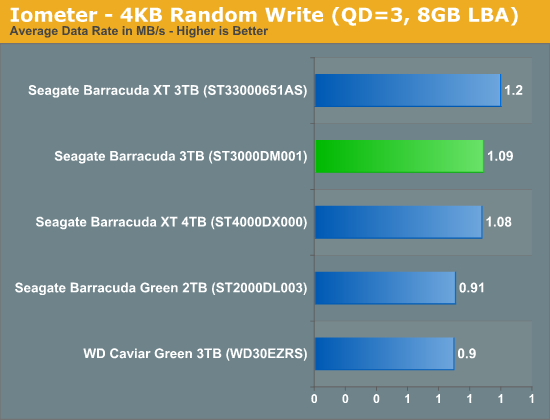
Random write performance actually dropped a bit compared to the older Barracuda XT. It's still higher than the Green drive, but it looks like Seagate has tweaked the drive's firmware a bit resulting in lower random write performance.

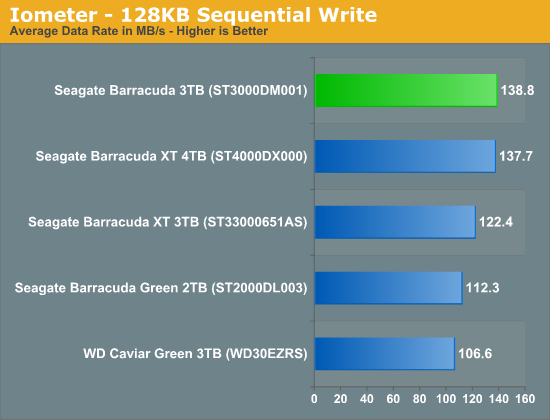
Sequential performance is up a bit over the original 3TB Barracuda XT, but about in-line with what we'd expect from a modern day high-capacity drive. Even compared to the latest 4TB Barracuda XT, we see a slight increase in performance.
Despite the sequential performance advantage, PCMark 7 showed the new Barracuda on-par with the Barracuda XT:
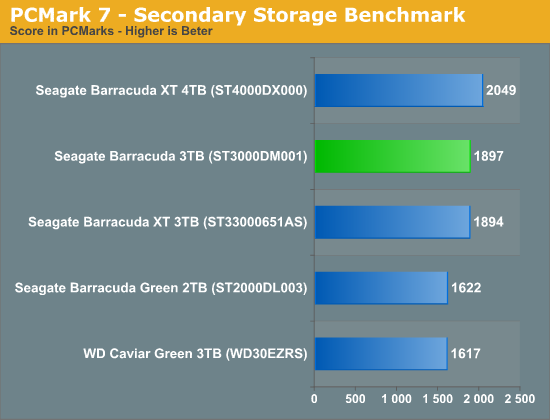
I ran the drives through our light and heavy 2011 workloads from our SSD reviews (which takes absolutely forever to run on mechanical drives) and saw some interesting data:
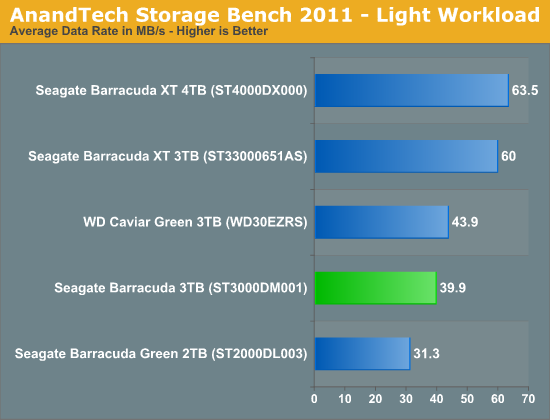

The Barracuda XT was consistently faster than the new 3TB Barracuda in our trace based benchmarks. Keep in mind that both of these tests were created on and for SSDs. Both tests involve a much heavier usage pattern and demand ultra quick response time, likely giving these hard drives an extremely strenuous workout. While the new Barracuda is faster than the outgoing Green, it seems as if the firmware isn't quite as tuned for performance as the XT. The difference does make sense, particularly if it translates into lower power usage given the new mainstream focused Barracuda lineup.
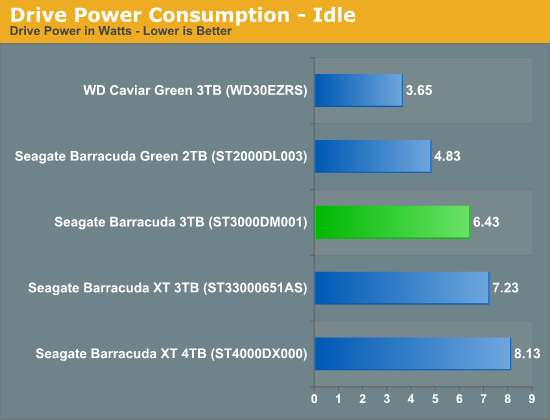
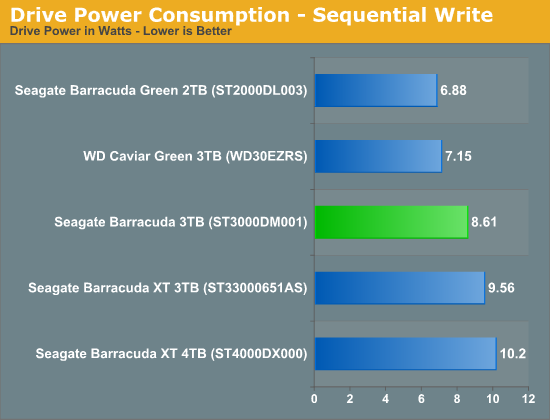
Power consumption is obviously lower than the old Barracuda XT, but still not quite as low as a 5400RPM Barracuda Green or WD Caviar Green. If you were expecting the new Barracuda to completely replace the outgoing Barracuda Green you will be disappointed. It looks like if you need a high capacity, low power 3.5" drive going forward it won't be from Seagate.
Final Words
The new 3TB Barracuda is a bit faster in sequential performance than the old Barracuda XT, at lower power consumption. In typical desktop workloads I think it's fairly safe to say that you wouldn't notice the difference between the Barracuda and Barracuda XT.
As our SSD tests showed us however, when really pushed the new Barracuda performs somewhere in between the old Green and the XT. Seagate appears to have optimized the drive's behavior for lower power rather than peak performance. If you want the absolute best performance out of a 3.5" drive, stick with the XT or wait for the new hybrid version.
Given the tremendous advantage SSDs offer over even the fastest 3.5" drives, I'm personally ok with the performance tradeoff under very heavy load so long as you've got an SSD somewhere in your system as well. I'm not sure I particularly agree with Seagate's decision to abandon the 5900RPM drive market, but thankfully there are other options available if you want a high capacity, lower power drive.




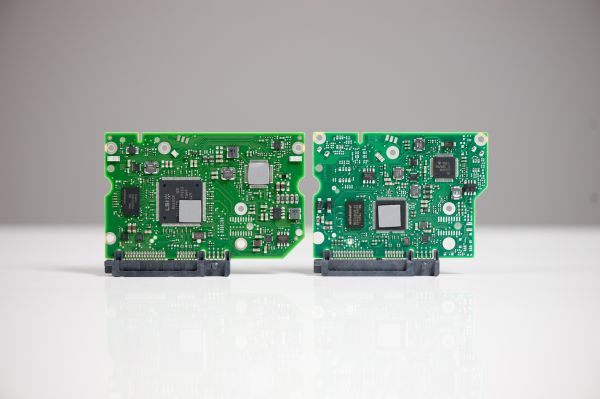
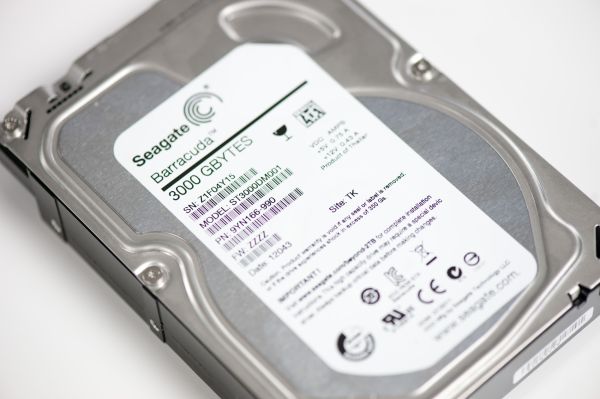








77 Comments
View All Comments
TrackSmart - Thursday, November 3, 2011 - link
Agreed (times 3). Some of these 4+ platter HDDs have absurdly high failure rates! Totally unacceptable. I wonder if reliability is one of the reasons for reducing the platter count on these larger drives by using 1 GB platters. If that's the case, I'm all for it.SSD for speed. HDD for file storage and backup - and it had better be reliable because we know it won't be fast.
Snotling - Thursday, November 3, 2011 - link
Don't bet on reliability from a lower end product. History tells us that older technology is not worked on to make it more reliable, only cheaper and those so called GREEN drives are targeted at the low cost customer who in the minds of the marketing geniuses deserve to have something that breaks early and breaks often.Super high-end performance may not have the maturity to be reliable but lower performance products are usually even worst. Reliability is found in the "enterprise class" which usually performs on the level of upper-mid-range to middle-high end. There is a reason for that, these parts are not prototypes anymore and they are not made of components rejected for manufacturing better products.
They're the real deal.
Sivar - Friday, November 4, 2011 - link
I agree regarding Samsung drives.Anecdotes are not data and all that, but Samsung is the one drive brand I've not had fail. I'm not talking about sample sizes of 2 or 3 -- I have 9 of just their 2TB F4 in my home server right now. I've worked with and owned over 400 hard drives.
I think I know my hard drives. I've set up six large storage servers; 2 for enterprise. I was the first moderator on StorageReview's forums, edited Eugene Ra's articles before publication, made friends with three hard drive engineers through many discussions. One of the other more prevalent users of that site owned Red Hill Computers in Australia. Since starting that company in the early 90's, only one Samsung drive was ever returned to him as defective, and that one had visible dents and was from a customer that wanted a refund and not a replacement. He suspected the customer damaged the drive intentionally to get some quick cash. Whether true or not, one return in several decades is notable.
I wouldn't touch Samsung's phones or televisions, but their hard drives are rock solid.
Locut0s - Thursday, November 3, 2011 - link
Cause the terrible mess that the HD market is in due to to the Thai flooding has even the old Barracuda Green 2TB selling for north of $220 on NewEgg right now!! And even at the low end I haven't seen it much lower than about $170-180. I can remember selling these drives for $70 or less only a few months ago when I was working computer retail.radium69 - Thursday, November 3, 2011 - link
Just build a pontoon under that damn factory in Thailand.Prices are going through the bloody roof.
Bought a 160gb WD a month ago for 38 euro.
Looked at their website now and it 79 euro.
Jeebus, more than 200% increase in price.
For that price I can buy extra ram.
There is no excuse for such a bloody increase in price.
mcturkey - Thursday, November 3, 2011 - link
You're right. The fact that the company making 75% of all hard drive motors for the entire industry is currently unable to produce anything is no excuse for prices skyrocketing. The fact that every computer manufacturer has purchased as much stock as they can to ensure they can still sell PCs is no excuse for prices skyrocketing. The fact that even once the flood waters fully recede, it will take 6-8 months for everything to come back online 100% is no excuse for prices skyrocketing. The fact that once we're back at 100% production, early drive production runs may be questionable due to downtime, inconsistent machine performance, etc is no excuse for prices skyrocketing.Seriously? I am so tired of seeing people say that the price jump is gouging. The limited supply of drives that retailers have are being sold at these prices, because those who absolutely need the storage are willing to pay it. I am willing to bet that unless a miracle happens, you won't be able to buy mechanical drives at all from most retailers for awhile next year. The limited amount of production that does exist will be snapped up by the PC makers to keep them afloat.
marvdmartian - Thursday, November 3, 2011 - link
And yet, how foolish is it of any company (or companies), to depend on getting 75% of ANY part required for their product, solely from one area of the world, which is known for having a monsoon season (and subsequent flooding)??While this year's flooding in Thailand is much worse than previous years have seen (the "hundred year flood" concept), it's still awfully foolish of these companies not to have spread their suppliers around. I'm sure there are factories in India and China that would have happily taken on part of the load in the past, thus negating this shortage, and minimizing it's impact.
In the meantime, as has been pointed out already, this might be a foolish decision, by Seagate, to trade cost for performance. Again, as already stated, reliability is much more important of a consideration, and I'd rather be stuck with a 5900rpm drive with a 3 to 5 year warranty, than a 7200 rpm drive with a 2 year warranty, especially if it's just going to be a storage drive.
Time will tell, how good of a decision this will be for Seagate.
name99 - Thursday, November 3, 2011 - link
"And yet, how foolish is it of any company (or companies), to depend on getting 75% of ANY part"Gee, it's like relying on a vital commodity (call it "oil") most of which comes from countries with unstable governments that could, at any time, collapse into war or revolution...
As long as you have a system (political and financial) that rewards people (CEOs and politicians) purely on short-term results, this is the way the world will work.
JackNSally - Thursday, November 3, 2011 - link
"most of which comes from countries with unstable governments that could, at any time, collapse into war or revolution..."So Canada and Mexico are unstable and at any time is about to collapse into war or revolution? (well, Mexico has it's problems with the drug cartels but that's mainly near the border)
ftp://ftp.eia.doe.gov/pub/oil_gas/petroleum/data_p...
name99 - Friday, November 4, 2011 - link
Don't be a retard. OIl is a fungible commodity.You think if Iran or Saudi Arabia stop exporting oil it won't affect the US?